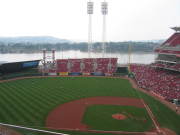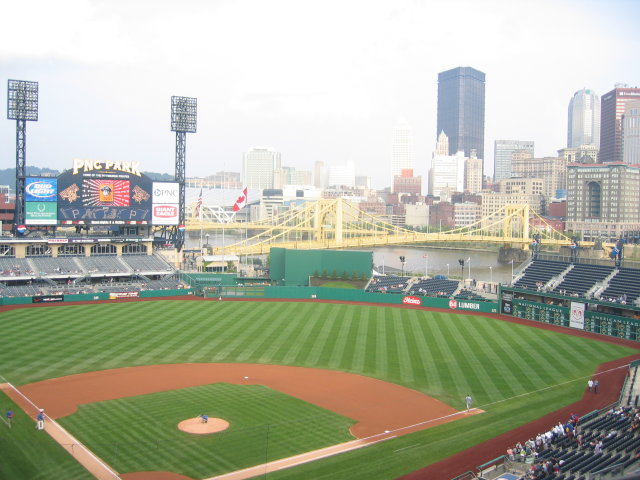


Baseball Toaster was unplugged on February 4, 2009.
Email me at btimmermann@gmail.com
Select a date:
While it’s not solely about baseball, Robert C. Trumpbour’s The New Cathedrals: Politics and Media in the History of Stadium Construction, is a surprisingly interesting read on a topic that is somewhat abstract. That is, the way the news media covers the political debate over funding and building new stadium projects in the United States. And while we might think of the news media as being far more boosterish in the early part of the 20th Century, that boosterism persists, even in a city like New York.
The title of Trumpbour’s book comes from his belief that in the past, a city would announce itself to the world as an important place by building a cathedral, but now cities do so by building enormous sports complexes. Instead of building a gigantic bell tower, teams build a snazzy baseball stadium with lots of cup holders, luxury suites, and lots of shopping to announce itself as “major league.” Somewhat ironically, I live in an area, Los Angeles, where there hasn’t been a new outdoor sports stadium, aside from the relatively small , in my lifetime, but there is a snazzy new cathedral!
Trumpbour uses four cities for his case studies: Cincinnati, Pittsburgh, Boston, and New York. And despite the differing economic situations of the four cities, as well as the fortunes of their baseball and football teams, each city has had a somewhat similar experience with media coverage of stadium deals, although the outcome was slightly different.

In Cincinnati, the media was completely behind the idea of state funding to build new stadiums for the Bengals and the Reds and would openly mock opponents of such a measure. And eventually, the people of Hamilton County approved funding to build what became Paul Brown Stadium and Great American Ballpark. Neither stadium has been a big financial or aesthetic success.
 Pittsburgh’s media was also behind the construction of a new facility for the Pirates and Steelers, although Pittsburgh didn’t have to worry too much about the Steelers trying to move. However, the Pirates made noises about seeking greener pastures and eventually the Steelers decided that they wanted to join in on the deal and Pennsylvania voters got to decide if the state would pony up some bucks to pay for the new facilities. The voters said no, so the Pennsylvania State Legislature just appropriated the money on their own. And while the Steelers have won a Super Bowl (in a year when they played all of their playoff games on the road), the Pirates have continued to be one of the worst teams in the majors. But they do have one nice-looking park!
Pittsburgh’s media was also behind the construction of a new facility for the Pirates and Steelers, although Pittsburgh didn’t have to worry too much about the Steelers trying to move. However, the Pirates made noises about seeking greener pastures and eventually the Steelers decided that they wanted to join in on the deal and Pennsylvania voters got to decide if the state would pony up some bucks to pay for the new facilities. The voters said no, so the Pennsylvania State Legislature just appropriated the money on their own. And while the Steelers have won a Super Bowl (in a year when they played all of their playoff games on the road), the Pirates have continued to be one of the worst teams in the majors. But they do have one nice-looking park!
In Boston, the Red Sox campaign to get a new stadium to replace Fenway never caught on, as the fans there loved the stadium warts and all. The Patriots were a different story as the old stadium in Foxborough was beloved by few and a series of Patriot owners tried to get a new building. The media in Boston was probably the most contentious toward owners who wanted new stadiums. The Patriots onfield success probably helped them toward a new stadium more than anything else.
New York gets two chapters as Trumpbour paints the historical background of stadium plans, especially how the Polo Grounds went from being state of the art when they reopened in 1911 after a fire to being obsolete as Yankee Stadium opened in 1923. And even though Yankee Stadium was renovated in the mid-1970s, the stadium was still portrayed as something of a death trap after a steel beam collapsed in 1998, forcing the relocation of one home game to Shea Stadium.
But Trumpbour writes mostly about the plan to build a stadium on the West Side of Manhattan that would serve as both a home for the New York Jets as well as the principal stadium for the 2012 Olympics. This tale ends up being quite convoluted and, as we well know, the Jets aren’t getting a stadium on the West Side of Manhattan nor are the Olympics coming to New York in 2012. But the Yankees and Mets are moving into new stadiums.
If you are looking for a book about the economics of public funding of stadiums, this isn’t it and Trumpbour admits it. You would be better served reading the writings of Andrew Zimbalist or Roger Noll on that matter. Trumpbour doesn’t think much of the claims of economic good times that come with a new stadium and presents a good case for it.
Trumpbour, a professor at Penn State’s Altoona campus, focuses on stadium battles in the East, but it would have been interesting to see how he viewed the media coverage in cities like Los Angeles (where new stadium ideas for a putative football team are usually shot down quickly), San Francisco (where the Giants new park was mostly privately funded), and San Diego (whose battle for public funding was so dramatic there should be a 12-part miniseries about it on PBS.)
But for how much longer can cities keep erecting new stadiums in an effort to appear “major league” and make money for team owners? Will the public put up with more people like Art Modell, then owner of the Cleveland Browns, and now the Baltimore Ravens, who told a group in Cleveland in 1996, “the pride and presence of a professional football team is far more important than thirty libraries.” Or will we just go back to building more cathedrals? You know, like the ones where bishops sit around and speak ex cathedra?
http://www.fieldofschemes.com/
I imagine the various print and television outlets in a given city benefit far out of proportion to the rest of the economy when there is a major local sports franchise. That could explain a bit of the boosterism that passes as economicy analysis in most print and media outlets.
Comment status: comments have been closed. Baseball Toaster is now out of business.